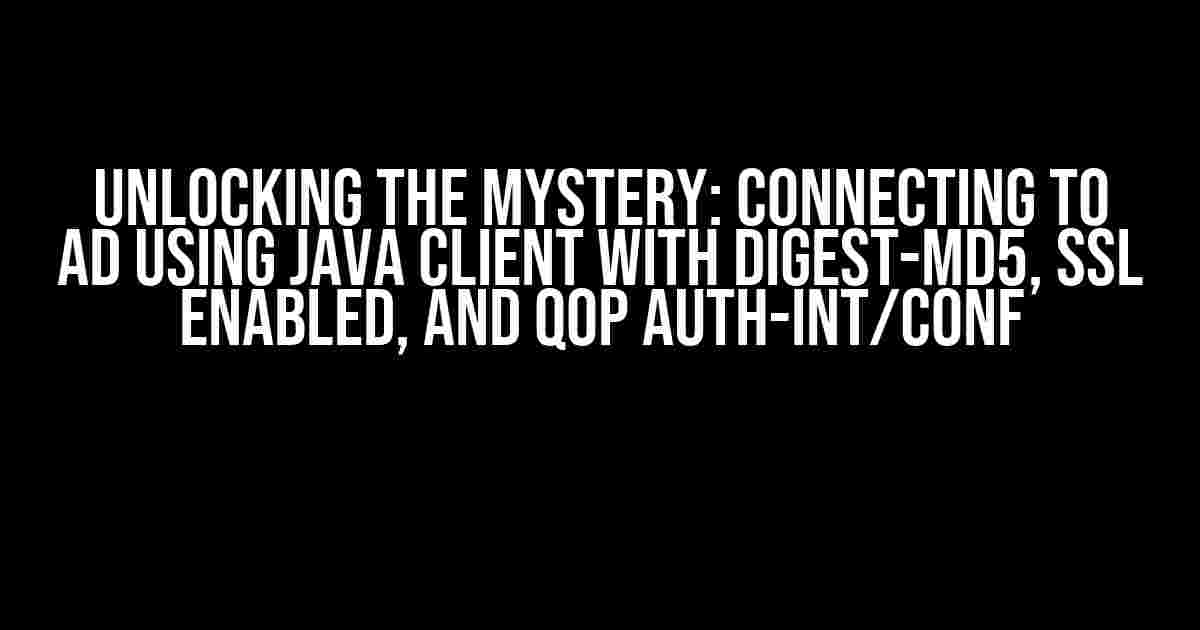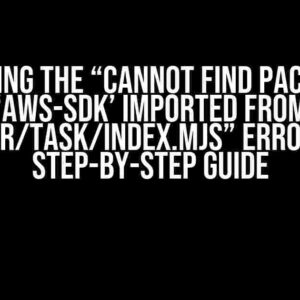Are you frustrated with the complexities of connecting to Active Directory (AD) using a Java client with digest-md5, SSL enabled, and QOP auth-int/conf? Do you feel like you’re stuck in a never-ending loop of trial and error? Fear not, dear Java developer! This article is here to guide you through the process, demystifying the intricacies and providing crystal-clear instructions to get you up and running in no time.
Understanding the Requirements
Before we dive into the implementation details, let’s break down the requirements:
- Digest-MD5: A challenge-response authentication mechanism that ensures the integrity of the password exchange between the client and server.
- SSL Enabled: Secure Sockets Layer (SSL) or Transport Layer Security (TLS) encryption is mandatory to protect the communication channel.
- QOP Auth-Int/Conf: Quality of Protection (QOP) is a security feature that enables channel binding and signing, providing an additional layer of protection against man-in-the-middle attacks.
Setting Up the Environment
Before you start coding, ensure you have the following components in place:
- Java 8 or later: The Java version should be compatible with the required libraries.
- Apache Directory API: The Apache Directory API (ApacheDS) provides a Java-based LDAP client implementation.
- Java Secure Socket Extension (JSSE): JSSE is required for SSL/TLS encryption.
- AD Server with Digest-MD5 and QOP Enabled: Your AD server should be configured to support digest-md5 and QOP auth-int/conf.
Configuring the Java Client
Create a new Java project and add the required dependencies to your project’s pom.xml file (if you’re using Maven) or your classpath:
<dependencies>
<dependency>
<groupId>org.apache.directory.sdk</groupId>
<artifactId>apache-ds-client</artifactId>
<version>2.0.0.AM25</version>
</dependency>
<dependency>
<groupId>javax.xml.bind</groupId>
<artifactId>jaxb-api</artifactId>
<version>2.3.0</version>
</dependency>
<dependency>
<groupId>com.sun.xml.bind</groupId>
<artifactId>jaxb-impl</artifactId>
<version>2.3.0</version>
</dependency>
</dependencies>
Implementing the LDAP Connection
Create a Java class to establish the LDAP connection:
import java.util.Hashtable;
import javax.naming.Context;
import javax.naming.directory.InitialDirContext;
import javax.naming.directory.DirContext;
import org.apache.directory.api.ldap.model.cursor.EntryCursor;
import org.apache.directory.api.ldap.model.exception.LdapException;
import org.apache.directory.api.ldap.model.message.BindRequest;
import org.apache.directory.api.ldap.model.message.BindResponse;
import org.apache.directory.api.ldap.model.message.LdapResult;
public class LdapConnection {
private static final String LDAP_URL = "ldap://your-ad-server:389";
private static final String USERNAME = "your-ad-username";
private static final String PASSWORD = "your-ad-password";
private static final String DIGEST_MD5_MECHANISM = "DIGEST-MD5";
public static void main(String[] args) throws Exception {
Hashtable<String, String> env = new Hashtable<>();
env.put(Context.INITIAL_CONTEXT_FACTORY, "com.sun.jndi.ldap.LdapCtxFactory");
env.put(Context.PROVIDER_URL, LDAP_URL);
env.put(Context.SECURITY_AUTHENTICATION, DIGEST_MD5_MECHANISM);
env.put(Context.SECURITY_PRINCIPAL, USERNAME);
env.put(Context.SECURITY_CREDENTIALS, PASSWORD);
DirContext ctx = new InitialDirContext(env);
// Perform the bind operation
BindRequest bindRequest = new BindRequest(USERNAME, PASSWORD, DIGEST_MD5_MECHANISM);
BindResponse bindResponse = (BindResponse) ctx.extendedOperation(bindRequest);
// Check the bind result
LdapResult ldapResult = bindResponse.getLdapResult();
if (ldapResult.getResultCode() == LdapResult.CODE_SUCCESS) {
System.out.println("Bind successful!");
} else {
System.out.println("Bind failed: " + ldapResult.getDiagnosticMessage());
}
// Perform LDAP operations...
}
}
Configuring QOP Auth-Int/Conf
To enable QOP auth-int/conf, you need to set the following system properties:
System.setProperty("javax.security.sasl.qop", "auth-int,conf");
System.setProperty("javax.net.ssl.keyStore", "path-to-your-keystore");
System.setProperty("javax.net.ssl.keyStorePassword", "your-keystore-password");
System.setProperty("javax.net.ssl.trustStore", "path-to-your-truststore");
System.setProperty("javax.net.ssl.trustStorePassword", "your-truststore-password");
Make sure to replace the placeholders with the actual values for your keystore and truststore files.
Enabling SSL/TLS Encryption
To establish an SSL/TLS connection, you need to configure the JSSE:
System.setProperty("javax.net.ssl.keyStoreType", "JKS");
System.setProperty("javax.net.ssl.trustStoreType", "JKS");
System.setProperty("javax.net.debug", "ssl");
// Initialize the SSL context
SSLContext sslContext = SSLContext.getInstance("TLSv1.2");
sslContext.init(null, null, null);
// Create an SSL socket factory
SSLSocketFactory sslSocketFactory = sslContext.getSocketFactory();
// Use the SSL socket factory for the LDAP connection
env.put("java.naming.ldap.factory.socket", sslSocketFactory);
Troubleshooting Common Issues
During the implementation, you might encounter the following issues:
| Issue | Solution |
|---|---|
| Bind failed: SASL DIGEST-MD5 authentication failed | Verify that the AD server is configured to support digest-md5 and QOP auth-int/conf. Ensure the correct username and password are used. |
| SSL handshake failed | Check the keystore and truststore configurations. Ensure the correct certificates are imported, and the passwords are correct. |
| Verify that the system properties for QOP are set correctly. Restart the Java application after setting the properties. |
Conclusion
By following this guide, you should now be able to connect to your AD server using a Java client with digest-md5, SSL enabled, and QOP auth-int/conf. Remember to carefully configure the environment, Java client, and system properties to ensure a successful connection. If you encounter any issues, refer to the troubleshooting section or seek guidance from your AD administrator.
Happy coding!
Frequently Asked Question
Get the scoop on connecting to AD using Java client with digest-md5, ssl enabled, and qop auth-int/conf when channel binding and signing are required in LDAP!
Why do I need to use digest-md5, ssl, and qop auth-int/conf in my Java client to connect to AD?
Using digest-md5, ssl, and qop auth-int/conf is necessary to ensure secure authentication and authorization when connecting to Active Directory (AD) from your Java client. Digest-md5 provides secure password hashing, ssl enables encryption, and qop auth-int/conf specifies the quality of protection for authentication, ensuring that the connection is both confidential and integral.
What is channel binding and signing, and how do I implement it in my Java client?
Channel binding and signing are security features that provide an additional layer of protection against man-in-the-middle attacks. In your Java client, you need to enable channel binding by setting the `java.security.auth.login.disableLoginAuthenticators` system property to `false` and configure the LDAP connection to use signing by setting the `com.sun.jndi.ldap.sdk.controlFactory` system property to `com.sun.jndi.ldap.sdk.SaslClientFactory`. This will force the LDAP connection to use signing and channel binding.
How do I specify the qop auth-int/conf in my Java client?
To specify the qop auth-int/conf in your Java client, you need to set the `javax.security.sasl.qop` system property to `auth-int` or `auth-conf`, depending on your security requirements. You can do this by adding the following line to your Java code: `System.setProperty(“javax.security.sasl.qop”, “auth-int”);` or `System.setProperty(“javax.security.sasl.qop”, “auth-conf”);`.
What are the common errors I might encounter when connecting to AD using digest-md5, ssl, and qop auth-int/conf?
Common errors you might encounter include authentication failures, SSL handshake failures, and invalid credential errors. Make sure to check your Java client configuration, LDAP server settings, and AD authentication policies to ensure that they are correctly configured. Also, verify that the required dependencies, such as the java.security.auth.login and com.sun.jndi.ldap.sdk packages, are in your classpath.
Are there any third-party libraries or tools that can simplify the process of connecting to AD using digest-md5, ssl, and qop auth-int/conf?
Yes, there are several third-party libraries and tools available that can simplify the process of connecting to AD using digest-md5, ssl, and qop auth-int/conf. Some popular ones include the Apache Directory Studio, UnboundID LDAP SDK, and the Spring LDAP library. These libraries provide pre-built functionality for LDAP authentication and can help reduce the complexity of implementing the required security configurations.


